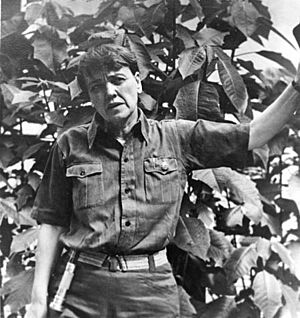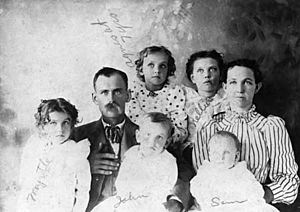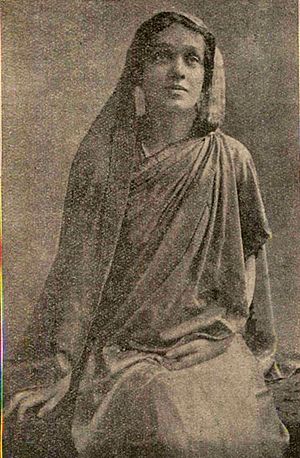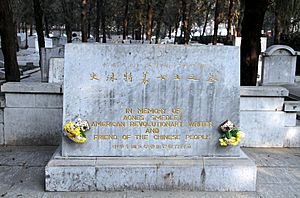Agnes Smedley facts for kids
Quick facts for kids
Agnes Smedley
|
|
|---|---|

Agnes Smedley, 1939
|
|
| Born | February 23, 1892 |
| Died | May 6, 1950 (aged 58) |
| Resting place | Babaoshan Revolutionary Cemetery, Beijing, China |
| Occupation | Journalist, writer |
|
Works
|
Daughter of Earth |
| Partner(s) | Virendranath Chattopadhyaya |
Agnes Smedley (born February 23, 1892 – died May 6, 1950) was an American journalist and writer. She was also an activist who supported important movements. These included the fight for India's freedom from British rule and the Chinese Communist Revolution.
Agnes grew up in a very poor family in Missouri and Colorado. Her father was a miner. Her experiences shaped her strong beliefs about women's rights and social fairness. She wrote about these ideas in her book Daughter of Earth (1929).
During World War I, while she was a college student, Agnes helped organize support for India's independence. After the war, she moved to Germany. There, she worked with Indian nationalists. From 1928 to 1941, she lived and worked in China as a journalist. She wrote a lot to support the communist cause during the Chinese Civil War. Later, during the Second Sino-Japanese War, she traveled with the Eighth Route Army. She even lived for a time in their base in Yan'an.
Besides Daughter of Earth, Agnes Smedley wrote four non-fiction books about China. She also wrote reports for newspapers in the United States, England, and Germany. One of her books was a biography of the Chinese communist general Zhu De.
Contents
Agnes Smedley's Early Life
Agnes Smedley was born in Osgood, Missouri, on February 23, 1892. She was the second of five children. In 1901, when she was nine, her family moved to Trinidad, Colorado. There, she saw many events from the coal miners' strike in 1903–04. Her father worked for coal companies, and the family moved often across Colorado.
She finished eighth grade in Tercio at age 16. At 17, Agnes passed a teacher's exam and taught in rural schools for a semester. She returned home when her mother, Sarah, became ill. Sarah died in early 1910.
Later that year, Agnes enrolled in a business school in Greeley, Colorado. She then worked as a traveling salesperson. In 1911, she felt unwell and checked into a sanatorium. A family friend in Arizona offered her a place to stay. From 1911 to 1912, Agnes attended Tempe Normal School. She became an editor for the school paper, Tempe Normal Student, and published her first writings there.
At Tempe, she met Thorberg Brundin and her brother Ernest Brundin. Both were members of the Socialist Party of America. They introduced Agnes to socialist ideas. When the Brundins moved to San Francisco, they invited Agnes to join them. In August 1912, Agnes married Ernest. However, the marriage did not last. By 1916, they divorced. In early 1917, Agnes moved to New York City.
Her sister-in-law, Thorberg Brundin, was also in New York. Agnes stayed with Thorberg and her husband in Greenwich Village for a few months.
Agnes Smedley's Career and Activism
Working for Indian Independence
Agnes Smedley became involved with Indian revolutionaries in the United States. These included M. N. Roy and Shailendranath Ghosh. They wanted to end British rule in India. They saw World War I as a chance to achieve their goal. They began working with Germany, which wanted to distract Britain from the war in Europe.
This cooperation was known as the Hindu–German Conspiracy. The U.S. government soon took action against the Indians. Roy and Ghosh moved to Mexico. They asked Agnes to help coordinate their group's activities in the U.S. This included running an office and publishing anti-British writings. Germany continued to fund most of these activities.
Both American and British military intelligence became interested in Agnes's work. To avoid being watched, Agnes moved often. She changed addresses ten times between May 1917 and March 1918.
In March 1918, the U.S. Naval Intelligence Bureau arrested Agnes. She was accused of breaking the Espionage Act. She was held for two months and then released on bail. Agnes spent the next year and a half fighting the accusations. The charges were dropped in late 1919. Agnes continued to help Indians who had been accused in the Hindu–German Conspiracy Trial.
She then moved to Germany. There, she met an Indian communist named Virendranath Chattopadhyaya. She lived with him for several years in Germany. They were involved in various left-wing causes.
In 1928, she finished her book Daughter of Earth. She then left Chattopadhyaya and moved to Shanghai. She worked as a correspondent for a German newspaper. Daughter of Earth was published in 1929 and was well-received.
Years in China

In China, Agnes Smedley worked as a journalist for newspapers like the Frankfurter Zeitung and the Manchester Guardian. She reported on many events, including the Anti-Japanese War. She was in Xi'an during the Xi'an Incident in December 1936. She even broadcasted in English for the rebels.
She then reported on the Second Sino-Japanese War. She traveled with the 8th Route Army in 1937 and the New Fourth Army in 1938–39. She also visited some units of the non-Communist Chinese army.
Agnes applied to join the Chinese Communist Party in 1937. However, she was not accepted. The Party had concerns about her independence. Agnes was very disappointed but remained dedicated to the Chinese communist cause.
Agnes left Yan'an in 1937. After that, she helped organize medical supplies and continued writing. From 1938 to 1941, she visited both Communist and Kuomintang forces in the war zone. During her time with Communist forces in Yan'an, after the Long March, she interviewed General Zhu De extensively. These interviews became the basis for her book about him. The actress and writer Wang Ying helped her with the book later.
Her travels covering the Chinese war front were some of the longest by any foreign correspondent.
Final Years and Legacy
Agnes moved to Washington, D.C., in 1941. She worked to support China and wrote several books about China's revolution. In the mid-1940s, she was an important voice supporting the Chinese Communists on public forums and NBC radio. Her 1944 book Battle Hymn of China was widely read.
In the 1940s, she lived at Yaddo, a writer's colony. In 1947, she was accused of espionage and watched by the FBI. Feeling pressure, she left the U.S. in late 1949. She died in the UK in 1950 after surgery.
Her ashes were buried at the Babaoshan Revolutionary Cemetery in Beijing in 1951.
Agnes Smedley's last book, a biography of Zhu De, was not finished when she died. It was published in 1956.
Agnes Smedley is honored in Judy Chicago's art installation The Dinner Party. Her name is among the 999 names on the Heritage Floor.
See also
 In Spanish: Agnes Smedley para niños
In Spanish: Agnes Smedley para niños
- Jack Belden – fellow correspondent in China
- Xu Zhimo – Chinese poet with whom Smedley was romantically involved
- Anna Louise Strong – fellow supporter of Chinese communism




